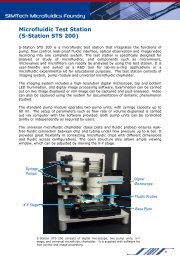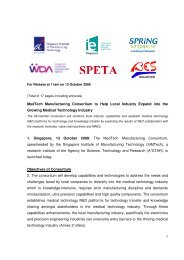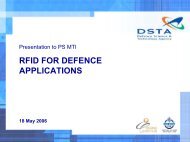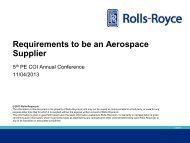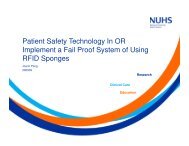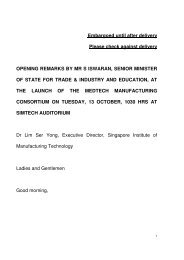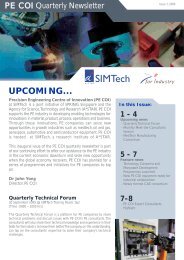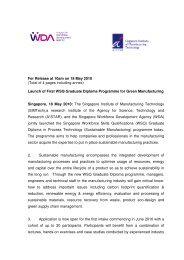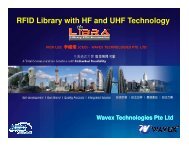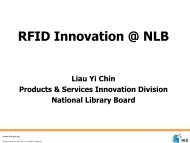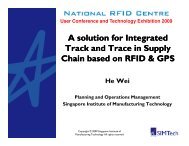R & S Presentation.pdf - National RFID Centre
R & S Presentation.pdf - National RFID Centre
R & S Presentation.pdf - National RFID Centre
You also want an ePaper? Increase the reach of your titles
YUMPU automatically turns print PDFs into web optimized ePapers that Google loves.
<strong>RFID</strong> Testing<br />
Sun Wai Hoong<br />
Asst. R&D Manager<br />
July 2009 Rohde and Schwarz Systems and Communications Asia<br />
1
Agenda<br />
Introduction<br />
<strong>RFID</strong> Technology Overview<br />
Global Market Projections<br />
Technology<br />
Testing standards<br />
R&S <strong>RFID</strong>-related<br />
products<br />
<strong>RFID</strong> Systems Overview<br />
Coupling,Backscattering<br />
Modulation<br />
Testing Overview<br />
Regulatory Testing<br />
Conformance Testing<br />
Performance Testing<br />
Products Overview<br />
Test Setup – PCD / PICC<br />
July 2009 Rohde and Schwarz Systems and Communications Asia<br />
2
<strong>RFID</strong> Technology Overview<br />
Frequency<br />
Range<br />
segment Range Application Standardisation Technology<br />
125 kHz / 135 kHz remote coupling 0,5 m animal identification (read only) ISO 11784 Inductive<br />
125 kHz / 135 kHz remote coupling 0,5 m animal identification (read/write) ISO 14223/1 Inductive<br />
125 kHz / 135 kHz remote coupling 0,5 m logistic ISO18000-2 electromagnetic / backscatter<br />
0 to 30 MHz close coupling 10 cm high security ISO 10536 ID1-Format inductive / capacitive<br />
6,7 MHz remote coupling 1 m<br />
7,4 to 8,8 MHz remote coupling 1 m<br />
13,56 MHz remote coupling 1 m proximity cards (contactless controller) ISO 14443 Inductive<br />
13,56 MHz remote coupling 1 m vicinity cards (contactless memory) ISO15693 Inductive<br />
13,56 MHz remote coupling 1 m logistic ISO 18000-3 electromagnetic / backscatter<br />
13,56 MHz remote coupling 1 m electronic product code EPC Class I RF Inductive<br />
mobile nearfield communication<br />
13,56 MHz remote coupling 1 m<br />
(smartcard payment) NFC ECMA 340 Inductive<br />
27 MHz remote coupling 1 m inductive (capacitive)<br />
125 MHz<br />
302 to 305 MHz long range system up to 100 m<br />
314,7 to 315 MHz long range system up to 100 m<br />
418,95 to 418,975 MHz long range system up to 100 m<br />
433 MHz long range system up to 100 m logistic ISO 18000-7 electromagnetic / backscatter<br />
860 to 960 MHz long range system 3 m / 15 m logistic ISO 18000-6 electromagnetic / backscatter<br />
electronic product code<br />
860 to 960 MHz long range system 3 m / 15 m (reading multiple Tags) EPC Class I Gen 2 electromagnetic / backscatter<br />
2,4 to 2,4835 GHz, 2,45 long range system 3 m / 15 m logistic ISO 18000-4 electromagnetic / backscatter<br />
2,4 to 2,4835 GHz, 2,45<br />
GHz long range system 3 m / 15 m Vehicle identification electromagnetic / backscatter<br />
5,725 to 5,875 GHz long range system 3 m / 15 m logistic ISO 18000-5 electromagnetic / backscatter<br />
5,725 to 5,875 GHz long range system 3 m / 15 m special sensor application electromagnetic / backscatter<br />
24,125 GHz<br />
July 2009 Rohde and Schwarz Systems and Communications Asia<br />
3
Global Market Projections<br />
Source: IDTechEx <strong>RFID</strong> Forecasts, Players & Opportunities 2008-2018<br />
l Exponential growth for <strong>RFID</strong> market from 2008 – 2018<br />
l Market size in 2018 is > 5 times that for 2008<br />
l Main reason for adoption<br />
l Increase efficiency & reduce wastage<br />
July 2009 Rohde and Schwarz Systems and Communications Asia<br />
4
Typical Components of an <strong>RFID</strong> System<br />
<strong>RFID</strong> Readers<br />
Data<br />
Clock<br />
Energy<br />
Contactless<br />
Data carrier<br />
(Transponder)<br />
Application<br />
Devices to test<br />
July 2009 Rohde and Schwarz Systems and Communications Asia<br />
5
<strong>RFID</strong> Systems can be classified by:<br />
Frequency<br />
Communication distance<br />
Size of the Memory<br />
Technology<br />
July 2009 Rohde and Schwarz Systems and Communications Asia<br />
6
Classification in terms of Frequency use<br />
Frequency<br />
classification<br />
LF<br />
HF<br />
HF<br />
HF<br />
HF<br />
HF<br />
UHF<br />
UHF<br />
UHF<br />
UHF<br />
UHF<br />
UHF<br />
Microwave<br />
Microwave<br />
Microwave<br />
Frequency<br />
125 kHz / 135 kHz<br />
0 to 30 MHz<br />
6,7 MHz<br />
7,4 to 8,8 MHz<br />
13,56 MHz<br />
27 MHz<br />
125 MHz<br />
302 to 305 MHz<br />
314,7 to 315 MHz<br />
418,95 to 418,975 MHz<br />
433 MHz<br />
860 to 960 MHz<br />
2,4 to 2,4835 GHz, 2,45 GHz<br />
5,725 to 5,875 GHz<br />
24,125 GHz<br />
Source (Chipsets percentage) : Venture Development Cooperation, 2007<br />
28 % of Chipsets<br />
38 % of Chipsets<br />
18 % of Chipsets<br />
5 % of Chipsets<br />
LF = Low Frequency<br />
HF = High Frequency<br />
UHF = Ultra High Frequency<br />
July 2009 Rohde and Schwarz Systems and Communications Asia<br />
7
Classification in terms of communication distance<br />
Range<br />
Frequency<br />
Technic<br />
Close Coupling<br />
- 0,01 m<br />
DC - 30 MHz<br />
Inductive coupling<br />
Capacitive coupling<br />
Remote Coupling<br />
- 1 m<br />
135 kHz,<br />
13.56 MHz,<br />
(27.125 MHz)<br />
Inductive coupling<br />
Long-range System - 3 m / 15 m<br />
868 MHz,<br />
915 MHz,<br />
2.5 GHz und<br />
5.8 GHz<br />
Backscatter coupling<br />
(Electromagnetic coupling)<br />
July 2009 Rohde and Schwarz Systems and Communications Asia<br />
8
Inductive Coupling<br />
Remote coupling ~ 1m<br />
(Load Modulation)<br />
Resistance<br />
Reader<br />
coupling coefficient k
Inductive coupling<br />
Close coupling ~ 10cm<br />
Reader<br />
Chip<br />
July 2009 Rohde and Schwarz Systems and Communications Asia<br />
10
Inductive coupling in the example of EAS Systems (Electronic<br />
Article Surveillance)<br />
Energy<br />
fG<br />
Generator coil<br />
Sensory coil<br />
UHF<br />
Transmitter<br />
EAS-Label<br />
Receiver<br />
Reaction<br />
Reaction<br />
(optimal)<br />
Typical parameter for LC-System: FG = 8.2 MHz + 10 %<br />
Maximum field-strength in detection area: 0.9 A/m<br />
Minimum deactivation field-strength: 1.5 A/m<br />
Detection Rate: ca. 70%<br />
Source: Finkenzeller<br />
July 2009 Rohde and Schwarz Systems and Communications Asia<br />
11
Capacitive coupling<br />
Close coupling ~ 10cm<br />
~<br />
Reader<br />
Chip<br />
July 2009 Rohde and Schwarz Systems and Communications Asia<br />
12
Backscatter coupling / Electromagnetic coupling<br />
Wavefront<br />
from Reader<br />
reflected wavefront<br />
from transponder<br />
Through resonance of the receiving circuit, the<br />
transponder has an especially high reflection coefficient.<br />
The reflection can be modified (modulated) with the use of<br />
a variable resistance<br />
July 2009 Rohde and Schwarz Systems and Communications Asia<br />
13
Backscatter Coupling<br />
modulated cross-section of the reflector (Radar)<br />
Range: ~ 10 m<br />
Directional<br />
Coupler<br />
P1<br />
P1<br />
Channel<br />
Reception<br />
TX<br />
D1<br />
C1<br />
D2<br />
C2<br />
CHIP<br />
Reader<br />
RX<br />
P2<br />
P2<br />
RL<br />
Transponder<br />
Dipole<br />
Source: Finkenzeller<br />
July 2009 Rohde and Schwarz Systems and Communications Asia<br />
14
Surface Waves Transponder<br />
Dipole<br />
antenna<br />
Reflectors<br />
Interdigital<br />
converter<br />
piezo-electric single crystal<br />
Substrate: lithium niobate or lithium tantalate: piezo-electric effect<br />
July 2009 Rohde and Schwarz Systems and Communications Asia<br />
15
Digital Modulation<br />
in the Time domain<br />
Amplitude Shift Keying<br />
(ASK)<br />
Baseband Data<br />
1 0 0 1<br />
Acos(ωt)<br />
Frequency Shift Keying<br />
(FSK)<br />
f 1 f 0 f 0 f 1<br />
Phase Shift Keying (PSK) (BPSK)<br />
S 1 S 0 S 0 S 1<br />
where f 0 =Acos(ω c -∆ω)t and f 1 =Acos(ω c +∆ω)t<br />
where S 0 =-Acos(ω c t) and S 1 =Acos(ω c t)<br />
July 2009 Rohde and Schwarz Systems and Communications Asia<br />
16
Load Modulation with Sub-carrier (inductive)<br />
13.56 MHz Reader‘s carrier signal,<br />
measured at antenna‘s coil<br />
Modulation products from load modulation<br />
on sub-carrier<br />
e.g. f c/ 16 = 847.5 kHz (ISO 14443)<br />
The sub-carrier can be modulated by ASK, FSK or PSK. It is achieved through<br />
periodic changes of the load in transponder.<br />
This gives rise to AM sidebands, which can be easily detected from the Reader<br />
July 2009 Rohde and Schwarz Systems and Communications Asia<br />
17
Full- and Half-Duplex Systems<br />
FDX (Full Duplex)<br />
Energy transfer<br />
Downlink:<br />
Uplink:<br />
HDX (Half Duplex)<br />
Energy transfer:<br />
Downlink:<br />
Uplink:<br />
SEQ (Sequential)<br />
Energy transfer:<br />
Downlink:<br />
Uplink:<br />
July 2009 Rohde and Schwarz Systems and Communications Asia<br />
18
<strong>RFID</strong> further technical Aspects<br />
Energy Supply<br />
Active<br />
Range is increased by approx. 15 m<br />
mainly only chip (memory) is supplied with power, not the<br />
transmitter<br />
The main frequency for active Tags is 433 MHz<br />
Passive<br />
Tag is driven only by the power of the Reader<br />
Range is mostly limited to 3 m<br />
Memory<br />
1 Byte to<br />
512 k Byte<br />
July 2009 Rohde and Schwarz Systems and Communications Asia<br />
19
smart card OS,<br />
cryptographic<br />
coprocessor<br />
smart card operating<br />
system<br />
authentication,<br />
encryption (state<br />
machine)<br />
anticollision<br />
read-write<br />
functionally<br />
Classification by Memory<br />
Passive transponder<br />
135 kHz, 13,56 MHz,<br />
868/915 MHz, 2,45 GHz<br />
ISO 15693, ISO 18000<br />
ISO 14223<br />
ISO 14443<br />
contactless<br />
smartcard<br />
13,56 MHz<br />
ISO 14443 dual<br />
interface<br />
smartcard<br />
Active transponder<br />
868/915 MHz 2,45 GHz<br />
ISO 18000<br />
EAS<br />
read-only<br />
fixed code<br />
transponder<br />
EAS = Electronic Articel Surveillance<br />
Bytes of Memory<br />
1 4 16 64 512 2k 8k 32k 128k<br />
July 2009 Rohde and Schwarz Systems and Communications Asia<br />
20
Standardisation Bodies<br />
International<br />
ISO<br />
IEC<br />
ITU<br />
<strong>National</strong><br />
ANSI (US)<br />
BSI (UK)<br />
China <strong>RFID</strong> WG<br />
Industrial<br />
ATA<br />
EIA<br />
EPC<br />
UPU<br />
July 2009 Rohde and Schwarz Systems and Communications Asia<br />
21
Standardisation Segmentation<br />
Technology (Physical and MAC)<br />
Conformance and Test Specifications<br />
Higher Layers<br />
– Data Content<br />
ISO 15418<br />
ISO 15434<br />
ISO 15459<br />
ISO 15961<br />
ISO 15962<br />
ISO 24721<br />
– Application Standards<br />
ISO 10374<br />
ISO 11785 (Container Identification)<br />
ISO 18185<br />
Layer 7<br />
Layer 6<br />
Layer 5<br />
Session<br />
Layer 4 Transport<br />
Layer 3<br />
Layer 2<br />
Layer 1<br />
Application<br />
<strong>Presentation</strong><br />
Network<br />
MAC / DLL<br />
Phy<br />
July 2009 Rohde and Schwarz Systems and Communications Asia<br />
22
Standardization Segmentation<br />
l Testing at PHY and MAC layers can be broadly grouped into 3 areas<br />
l<br />
l<br />
l<br />
Regulatory Test (EMC Test)<br />
Conformance Test<br />
Performance Test<br />
July 2009 Rohde and Schwarz Systems and Communications Asia<br />
23
Regulatory Testing<br />
Overview of Regulatory Standards<br />
Organization, Country<br />
Standards<br />
FCC, USA CFR 47 Part 15 or Part 90<br />
OET Bulletin 63<br />
ANSI C63.4<br />
CE, Europe<br />
EMC 89/336/EEC Directive and<br />
revision 91/31/EEC, 93/68/EEC<br />
ETSI EN 301 489-1<br />
ETSI EN 301 489-3<br />
Compulsory for <strong>RFID</strong> manufacturers<br />
– Ensure EMI/EMS compliance<br />
– Regulatory testing is compulsory for all electrical/electronic devices<br />
in the marketplace<br />
July 2009 Rohde and Schwarz Systems and Communications Asia<br />
24
Regulatory Testing<br />
Computer<br />
Software<br />
<strong>RFID</strong><br />
Signalling<br />
Unit<br />
Test<br />
Receiver<br />
DUT<br />
SG<br />
AMP<br />
l <strong>RFID</strong> Signalling Unit communicates with DUT<br />
l Interference from nearby electronic devices on DUT simulated by signal<br />
generator (SG) and amplifier (AMP)<br />
l Test Receiver measures spectral emissions from DUT<br />
July 2009 Rohde and Schwarz Systems and Communications Asia<br />
25
Regulatory Testing<br />
Tests that are conducted<br />
EMI<br />
– Electromagnetic interference<br />
– Ensures that the <strong>RFID</strong> device (tag or reader) does not emit<br />
excessive spectral emissions and disturb the operation of other<br />
electronic devices nearby<br />
EMS<br />
– Electromagnetic susceptance<br />
– Ensures that the <strong>RFID</strong> device (tag or reader) can withstand<br />
specified limits of spectral emissions from nearby electronic devices<br />
July 2009 Rohde and Schwarz Systems and Communications Asia<br />
26
Conformance Testing<br />
Overview of Conformance Standards<br />
Standard Frequency Application<br />
ISO 11784<br />
animal identification (read only)<br />
ISO 14223/1<br />
125 kHz / 135 kHz<br />
animal identification (read/write)<br />
ISO18000-2<br />
logistic<br />
ISO 10536 ID1-Format 0 to 30 MHz high security<br />
ISO 14443<br />
proximity cards (contactless controller)<br />
ISO15693<br />
vicinity cards (contactless memory)<br />
ISO 18000-3<br />
13,56 MHz<br />
logistic<br />
EPC Class I RF<br />
electronic product code<br />
NFC ECMA 340<br />
mobile nearfield communication (smartcard payment)<br />
ISO 18000-7 433 MHz logistic<br />
ISO 18000-6<br />
logistic<br />
860 to 960 MHz<br />
EPC Class I Gen 2<br />
electronic product code (reading multiple Tags)<br />
ISO 18000-4 2,4 to 2,4835 GHz, 2,45 GHz logistic<br />
ISO 18000-5 5,725 to 5,875 GHz logistic<br />
Useful for <strong>RFID</strong> manufacturers<br />
– Ensures reliable interaction between reader and tag<br />
– Allows for compatibility/interoperability with similar devices out in the<br />
marketplace<br />
July 2009 Rohde and Schwarz Systems and Communications Asia<br />
27
Conformance Test<br />
SOFTWARE BLOCK<br />
<strong>RFID</strong><br />
Signalling Unit<br />
Signal<br />
Generator<br />
Signal<br />
Analyzer<br />
Connection Matrix<br />
DUT<br />
l <strong>RFID</strong> Signalling Unit establishes communication with DUT<br />
l R=>T and T=>R<br />
l Physical and MAC measurements performed by Signal Analyzer<br />
l Signal Generator allows for interference testing<br />
July 2009 Rohde and Schwarz Systems and Communications Asia<br />
28
ISO 14443 Proximity cards<br />
Part 1: Physical characteristics<br />
– Mechanical properties of Proximity Integrated Chip Card (PICC)<br />
– Exposure limits to UV, X-Ray and electromagnetic radiation<br />
Part 2: Radio frequency power and signal interface<br />
– Limit of Reader‘s magnetic field 1.5 A/m < H < 7.5 A/m<br />
– Type A:<br />
– Chipcard => Reader: Load modulation with sub-carrier, ASK<br />
modulated, Manchester-Code, 106 kbits/s<br />
– Reader => Chipcard: ASK 100%, modified Miller-Code<br />
– Type B:<br />
– Chipcard => Reader: Load modulation with sub-carrier, BPSK,<br />
NRZ-Code, 106 kbits/s<br />
– Reader => Chipcard, ASK 10%, NRZ-Code<br />
July 2009 Rohde and Schwarz Systems and Communications Asia<br />
29
ISO 14443 Proximity cards<br />
Part 3: Initialisation and anticollision<br />
– Timing parameters<br />
– Frame delay time<br />
– PCD to PICC<br />
– PICC to PCD<br />
– Request Guard time<br />
– Frame formats<br />
– Short Frame<br />
– Standard Frame<br />
– Bit oriented anti-collision frame<br />
– Cyclic Redundancy Check<br />
– PICC States<br />
– Command Set<br />
– Select and anticollision sequence<br />
July 2009 Rohde and Schwarz Systems and Communications Asia<br />
30
ISO 14443 Proximity cards<br />
Part 4: Transmission protocols<br />
– Activation protocol for PICC<br />
– Transmission protocol<br />
– Deactivation protol for PICC<br />
July 2009 Rohde and Schwarz Systems and Communications Asia<br />
31
ISO 15693 Vicinity cards<br />
Part 1: Physical Characteristics<br />
– mechanical properties of Vicinity Integrated Chip Card (VICC)<br />
– Exposure limits to UV, X-Ray and electromagnetic radiation<br />
Part 2: Air Interface and initialisation<br />
– Limit of reader‘s magnetic field: 115mA/m
ISO 15693 Vicinity cards<br />
Part 3 : Transmission Protocols and anti-collision<br />
– Protocol<br />
– Modes<br />
– Request format<br />
– Request flags<br />
– Response format<br />
– Response flags<br />
– Response error code<br />
– VICC states<br />
– Anti-collision sequence and protocol<br />
July 2009 Rohde and Schwarz Systems and Communications Asia<br />
33
ISO 18000 Logistics<br />
Developed for Item Management; considers the demands for<br />
products and goods management<br />
<strong>RFID</strong> for Item Management: Air Interface<br />
– Part 1: Generic Parameter for Air Interface Communication for<br />
Globally accepted frequencies<br />
– Part 2: Parameters for Air Interface Communication below 135 kHz<br />
– Part 3: Parameters for Air Interface Communication at 13.56 MHz<br />
– Part 4: Parameters for Air Interface Communication at 2.45 MHz<br />
– Part 5: Parameters for Air Interface Communication at 5.8 GHz<br />
– Part 6: Parameters for Air Interface Communication - UHF<br />
Frequency Band<br />
July 2009 Rohde and Schwarz Systems and Communications Asia<br />
34
ISO 18000-6 (EPC Class 1 Gen 2)<br />
Tests that are conducted<br />
Signalling – Physical and media access control (MAC) parameters<br />
• Interrogator to tag (R => T) communications<br />
• Tag to interrogator (T => R) communications<br />
– Physical tests<br />
• Operating frequency, frequency mask, frequency hopping & channel<br />
• RF output power & envelope<br />
• Modulation / demodulation<br />
• Coding<br />
– MAC tests<br />
• Time parameters<br />
• Tag response & data<br />
Logical – operating procedure parameters<br />
– Tag inventory and access parameters<br />
– Collision management parameters<br />
July 2009 Rohde and Schwarz Systems and Communications Asia<br />
35
Performance Testing<br />
l Standards – ISO/IEC TR 18046<br />
l<br />
Outlines test methods to test performance characteristics of <strong>RFID</strong><br />
devices in actual operating environment<br />
l Important test for <strong>RFID</strong> adopters<br />
l<br />
l<br />
Allows the characterization of <strong>RFID</strong> systems<br />
Ensures compatibility between <strong>RFID</strong> devices<br />
l Anticipate potential issues in system and allows for solution /<br />
mitigation steps to be adopted ahead of deployment<br />
l<br />
Allows optimization of <strong>RFID</strong> systems<br />
l Tests that are conducted<br />
l Identification range and rate<br />
l Read range and rate<br />
l Write range and rate<br />
July 2009 Rohde and Schwarz Systems and Communications Asia<br />
36
Performance Test<br />
SOFTWARE BLOCK<br />
Signal<br />
Generator<br />
Interrogator<br />
Signal<br />
Analyzer<br />
coupler<br />
coupler<br />
Shielding<br />
Tag (DUT)<br />
l Interrogator (DUT) maintains communication with Tag (DUT)<br />
l Signal Generator to perform interference testing and act as a reference<br />
l Signal Analyzer to measure interrogator/backscatter strength and spectrum<br />
l Tag angle and distance to be varied using turntable<br />
l Allows plotting of signal strength at various distances and angles<br />
July 2009 Rohde and Schwarz Systems and Communications Asia<br />
37
Performance Test<br />
Top down view of communication zone<br />
July 2009 Rohde and Schwarz Systems and Communications Asia<br />
38
Performance Test<br />
Side view of communication zone<br />
July 2009 Rohde and Schwarz Systems and Communications Asia<br />
39
Performance Test<br />
Tabulation of performance test results<br />
July 2009 Rohde and Schwarz Systems and Communications Asia<br />
40
<strong>RFID</strong> Test Solutions from R&S<br />
Recommended Products<br />
Signal Generation<br />
Signal Analysis<br />
Test system<br />
R&S® SML<br />
R&S® SM300<br />
R&S® SMJ100A,<br />
R&S® SMU200A<br />
R&S® SMATE200A<br />
R&S® SMA<br />
R&S® SMR<br />
R&S® FSH 3/6 Handheld Spectrum Analyzer<br />
R&S® FS300<br />
R&S® FS315<br />
R&S® FSL<br />
R&S® FSP<br />
R&S® FSU<br />
R&S® FSQ<br />
Software option R&S® FS-K7 (FM demodulation)<br />
Software option R&S® FSQ-K70 (VSA)<br />
R&S® TS7810 <strong>RFID</strong> Test system<br />
Probes<br />
R&S® HZ-11 Probe set<br />
R&S® HZ-14 Probe set<br />
July 2009 Rohde and Schwarz Systems and Communications Asia<br />
41
Setup for Test of PICC<br />
Test data waveform<br />
transferred via<br />
LAN<br />
GPIB<br />
USB-STICK<br />
Software WinIQSim*<br />
PCD Simulator<br />
Signal<br />
Analyzer<br />
*WinIQSim is a free R&S software<br />
for creating user defined systems<br />
PICC<br />
(Device Under Test)<br />
July 2009 Rohde and Schwarz Systems and Communications Asia<br />
42
Setup for Test of PCD<br />
Test data waveform<br />
transferred via<br />
LAN<br />
GPIB<br />
USB-STICK<br />
Software WinIQSim*<br />
PICC Simulator<br />
Signal<br />
Analyzer<br />
*WinIQSim is a free R&S software<br />
for creating user defined systems<br />
<strong>RFID</strong> Reader<br />
(Device Under test)<br />
July 2009 Rohde and Schwarz Systems and Communications Asia<br />
43
Setup for PCD/PICC simulation<br />
Test data waveform<br />
transferred via<br />
LAN<br />
GPIB<br />
USB-STICK<br />
Software WinIQSim*<br />
PCD/PICC Signal<br />
Generation<br />
Signal Analyzer<br />
*WinIQSim is a free R&S software<br />
for creating user defined systems<br />
July 2009 Rohde and Schwarz Systems and Communications Asia<br />
44
ASK Modulation<br />
Pure ASK is very basic:<br />
Q<br />
Pure ASK 0%/100%<br />
1<br />
0<br />
I<br />
Power versus time ASK<br />
90%/100%<br />
Constellation<br />
July 2009 Rohde and Schwarz Systems and Communications Asia<br />
45
ASK Modulation<br />
ISO 14443 specifies the following parameters for<br />
ASK modulation:<br />
– ASK 100% (TYPE A)<br />
Subcarrier Frequency: fc/16<br />
Load modulation frequency is (fc+fc/16) = 14.407 MHz<br />
The data rate is (fc/128) = 106 kbits/s<br />
July 2009 Rohde and Schwarz Systems and Communications Asia<br />
46
1) Start creation of a single carrier system<br />
*WinIQSim is a free software from R&S for creating<br />
user defined systems<br />
July 2009 Rohde and Schwarz Systems and Communications Asia<br />
47
2) Set modulation to ASK<br />
ASK is a user-defined modulation type<br />
that requires a simple text file<br />
Symbol Rate = 105.9375 kHz (this<br />
corresponds to the duration of the “off”<br />
period<br />
July 2009 Rohde and Schwarz Systems and Communications Asia<br />
48
Data coding for Signal Generator<br />
1. Request from PCD to PICC<br />
2. Response from PICC to PCD<br />
SOF=Start of frame<br />
EOF=End of frame<br />
CRC=Check Sum Control<br />
July 2009 Rohde and Schwarz Systems and Communications Asia<br />
49
3) Create data string for payload<br />
July 2009 Rohde and Schwarz Systems and Communications Asia<br />
50
4) Define frame structure<br />
See slide about PCD to PICC or PICC to PCD<br />
configuration<br />
July 2009 Rohde and Schwarz Systems and Communications Asia<br />
51
5) Transfer waveform to the signal generator<br />
Test data waveform<br />
transferred via<br />
LAN<br />
GPIB<br />
USB-STICK<br />
(save waveform on harddisk)<br />
July 2009 Rohde and Schwarz Systems and Communications Asia<br />
52
6) Setup analyser<br />
Setup spectrumanalyser to centerfrequency of carrier<br />
(e.g. 13.56 MHz) with zero span (to analyse in time<br />
domain)<br />
Power<br />
(dB)<br />
Time<br />
July 2009 Rohde and Schwarz Systems and Communications Asia<br />
53
7) Setup vector signal analyser (FSQ-K70)<br />
July 2009 Rohde and Schwarz Systems and Communications Asia<br />
54
8) Analyse!<br />
Eye diagram<br />
Constellation diagram<br />
July 2009 Rohde and Schwarz Systems and Communications Asia<br />
55
8) Analyse!<br />
PCD measurements - t1 to t4<br />
July 2009 Rohde and Schwarz Systems and Communications Asia<br />
56
8) Analyse!<br />
Measuring t1<br />
July 2009 Rohde and Schwarz Systems and Communications Asia<br />
57
8) Analyse!<br />
Measuring t2<br />
July 2009 Rohde and Schwarz Systems and Communications Asia<br />
58
8) Analyse!<br />
Measuring t3<br />
July 2009 Rohde and Schwarz Systems and Communications Asia<br />
59
8) Analyse!<br />
Measuring t4<br />
July 2009 Rohde and Schwarz Systems and Communications Asia<br />
60
8) Analyse!<br />
Frame Delay Time – PCD to PICC<br />
July 2009 Rohde and Schwarz Systems and Communications Asia<br />
61
8) Analyse!<br />
Measuring Frame Delay Time – PCD to PICC<br />
July 2009 Rohde and Schwarz Systems and Communications Asia<br />
62
8) Analyse!<br />
Minimum load modulation amplitude – 22/H 0.5 mV<br />
Minimum PCD sensitivity – 18/H 0.5 mV<br />
July 2009 Rohde and Schwarz Systems and Communications Asia<br />
63
8) Analyse!<br />
Measuring load modulation amplitude – frequency domain<br />
July 2009 Rohde and Schwarz Systems and Communications Asia<br />
64
8) Analyse!<br />
Measuring load modulation amplitude – time domain<br />
July 2009 Rohde and Schwarz Systems and Communications Asia<br />
65
8) Analyse!<br />
Measuring load modulation power<br />
July 2009 Rohde and Schwarz Systems and Communications Asia<br />
66
8) Analyse!<br />
Measuring EMD disturbance<br />
July 2009 Rohde and Schwarz Systems and Communications Asia<br />
67
8) Analyse!<br />
Capturing symbols<br />
July 2009 Rohde and Schwarz Systems and Communications Asia<br />
68
8) Analyse!<br />
July 2009 Rohde and Schwarz Systems and Communications Asia<br />
69
8) Analyse!<br />
July 2009 Rohde and Schwarz Systems and Communications Asia<br />
70
IQ-data conversion in R&S FSL<br />
The low cost analyser R&S FSL provides a complete<br />
demodulation circuit that make it possible to decode the<br />
<strong>RFID</strong> signal.<br />
:TRACe1:IQ:SET NORM,3MHz,1MHz,EXT,POS,10,2000<br />
:TRACE:IQ:DATA?<br />
July 2009 Rohde and Schwarz Systems and Communications Asia<br />
71
Example of sampled data<br />
Relatively easy to decode the sample points into symbols:<br />
0111 1011 1111 1011 1110 1 ……..<br />
July 2009 Rohde and Schwarz Systems and Communications Asia<br />
72
Free <strong>RFID</strong>-software for R&S FSL<br />
July 2009 Rohde and Schwarz Systems and Communications Asia<br />
73
Application note<br />
Available under www.rohde-schwarz.com<br />
Select Application Note<br />
Select <strong>RFID</strong> RSI01<br />
July 2009 Rohde and Schwarz Systems and Communications Asia<br />
74
Conclusion<br />
l Growing market for <strong>RFID</strong> from 2008-2018<br />
l To increase efficiencies<br />
l Reduce wastage<br />
l <strong>RFID</strong> testing can be broadly divided into 3 areas<br />
l Regulatory Testing<br />
l<br />
Conformance Testing<br />
l Performance Testing<br />
l Rohde & Schwarz offers a wide range of equipment for <strong>RFID</strong> testing<br />
July 2009 Rohde and Schwarz Systems and Communications Asia<br />
75
July 2009 Rohde and Schwarz Systems and Communications Asia<br />
76



